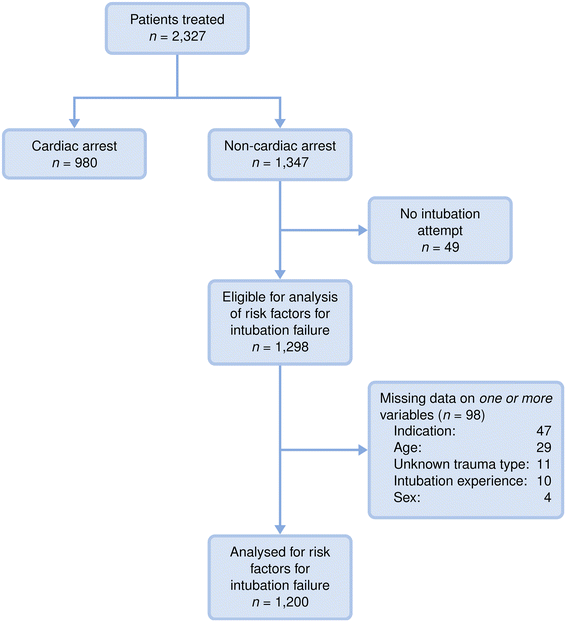Airway management by physician-staffed Helicopter Emergency Medical Services - a prospective, multicentre, observational study of 2,327 patients
- PMID: 26250700
- PMCID: PMC4528299
- DOI: 10.1186/s13049-015-0136-9
Airway management by physician-staffed Helicopter Emergency Medical Services - a prospective, multicentre, observational study of 2,327 patients
Abstract
Background: Despite numerous studies on prehospital airway management, results are difficult to compare due to inconsistent or heterogeneous data. The objective of this study was to assess advanced airway management from international physician-staffed helicopter emergency medical services.
Methods: We collected airway data from 21 helicopter emergency medical services in Australia, England, Finland, Hungary, Norway and Switzerland over a 12-month period. A uniform Utstein-style airway template was used for collecting data.
Results: The participating services attended 14,703 patients on primary missions during the study period, and 2,327 (16 %) required advanced prehospital airway interventions. Of these, tracheal intubation was attempted in 92 % of the cases. The rest were managed with supraglottic airway devices (5 %), bag-valve-mask ventilation (2 %) or continuous positive airway pressure (0.2 %). Intubation failure rates were 14.5 % (first-attempt) and 1.2 % (overall). Cardiac arrest patients showed significantly higher first-attempt intubation failure rates (odds ratio: 2.0; 95 % CI: 1.5-2.6; p < 0.001) compared to non-cardiac arrest patients. Complications were recorded in 13 %, with recognised oesophageal intubation being the most frequent (25 % of all patients with complications). For non-cardiac arrest patients, important risk predictors for first-attempt failure were patient age (a non-linear association) and administration of sedatives (reduced failure risk). The patient's sex, provider's intubation experience, trauma type (patient category), indication for airway intervention and use of neuromuscular blocking agents were not risk factors for first-attempt intubation failure.
Conclusions: Advanced airway management in physician-staffed prehospital services was performed frequently, with high intubation success rates and low complication rates overall. However, cardiac arrest patients showed significantly higher first-attempt failure rates compared to non-cardiac arrest patients. All failed intubations were handled successfully with a rescue device or surgical airway.
Study registration: www.clinicaltrials.gov NCT01502111 . Registered 22 December 2011.
Figures
References
Publication types
MeSH terms
Associated data
LinkOut - more resources
Full Text Sources
Other Literature Sources
Medical



